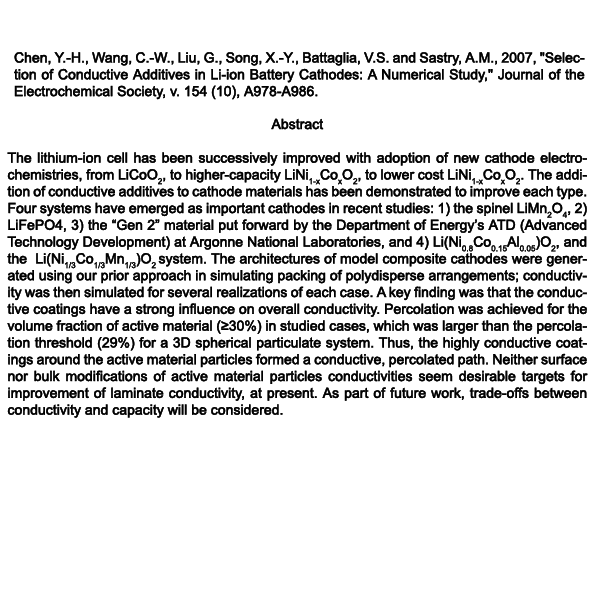|
Chen, Y.-H., Wang, C.-W., Liu, G., Song, X.-Y., Battaglia, V.S. and Sastry, A.M., (2007) "Selection of Conductive Additives in Li-ion Battery Cathodes: A Numerical Study," Journal of the Electrochemical Society, v 154 (10), ppA978-A98.
Abstract
The lithium-ion cell has been successively improved with adoption of new cathode electrochemistries, from LiCoO2, to higher-capacity LiNi1-xCoxO2, to lower cost LiNi1-xCoxO2. The addition of conductive additives to cathode materials has been demonstrated to improve each type. Four systems have emerged as important cathodes in recent studies: 1) the spinel LiMn2O4, 2) LiFePO4, 3) the “Gen 2” material put forward by the Department of Energy’s ATD (Advanced Technology Development) at Argonne National Laboratories, and 4) Li(Ni0.8Co0.15Al0.05)O2, and the Li(Ni1/3Co1/3Mn1/3)O2 system. The architectures of model composite cathodes were generated using our prior approach in simulating packing of polydisperse arrangements; conductivity was then simulated for several realizations of each case. A key finding was that the conductive coatings have a strong influence on overall conductivity. Percolation was achieved for the volume fraction of active material (&Mac179;30%) in studied cases, which was larger than the percolation threshold (29%) for a 3D spherical particulate system. Thus, the highly conductive coatings around the active material particles formed a conductive, percolated path. Neither surface nor bulk modifications of active material particles conductivities seem desirable targets for improvement of laminate conductivity, at present. As part of future work, trade-offs between conductivity and capacity will be considered.
|
|
|
